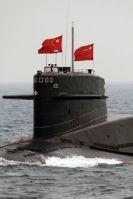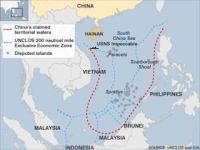
Chinese Navy nuclear submarine takes part in an international fleet review in Qingdao in 2009 / Reuters
TOKYO – Never mind natural resources or national pride.
China’s rapid military modernization and aggressive territorial claims are rooted in the calculus of nuclear deterrence, according to defense analysts in Japan.
Sumihiko Kawamura, deputy director of the conservative Okazaki Institute in Tokyo, says China has claimed virtually all of the South China Sea and is developing aircraft carriers and stealth fighter planes largely to secure a haven for ballistic missile submarines.
This would allow China to strike back if the US or other opponent were to destroy China’s land-based missiles in a first strike. China’s shallow coastal waters currently leave little room for nuclear submarines to hide.
“You cannot understand China’s maritime policy without considering the nuclear dimension,” says Kawamura, a retired admiral in Japan’s maritime self-defense forces – aka, the Japanese Navy.
“China wants to become a military superpower. To do that, it has to acquire a second-strike capability, and they are eager to grow that capability. That is the reason they want to control all of the South China Sea, “says Kawamura.
In recent years, China increasingly has sent its navy and armed patrol ships into surrounding waters to assert control over territory variously claimed by Japan, Vietnam, the Philippines and others.
A particular flashpoint has been the South China Sea, which China claims virtually in its entirety.
One-third of the world’s shipping passes through that waterway, including 90 percent of Japan’s imported oil. It is rich in commercial fishing resources and is believed to hold large deposits of oil and gas.

China claims nearly all of the South China Sea / BBC
In July, Vietnam and the Philippines conducted live-fire military exercises to protest the intrusion of Chinese warships into parts of the South China Sea that each country claims.
Earlier, a Chinese helicopter buzzed a Japanese destroyer in disputed waters near Japan. And in 2009 Chinese warships attempted to destroy equipment operated by the US Navy surveillance ship Impeccable.
Tetsuo Kotani, senior research fellow at the Research Institute for Peace and Security in Tokyo, says the push into the South China Sea – half-again the size of the Mediterranean and five miles deep in places — is an integral part of China’s nuclear weapons strategy.
China is building a submarine base on Hainan Island in the South China Sea and plans to introduce up to five Type 094, or Jin-class, submarines outfitted with new JL-2 missiles. Those missiles have an estimated range of 8,000 kilometers – enough to strike US bases in Asia and Hawaii.
“Possessing a credible sea-based nuclear deterrent is a priority for China’s military strategy,” Kotani wrote in The Diplomat in July. “Without understanding the nuclear dimension of South China Sea disputes, China’s maritime expansion makes no sense.”
During the Cold War, the Soviet Pacific Fleet deployed some 100 attack submarines and 140 surface warships and strengthened its land defenses to create a similar safe haven for ballistic submarines in the Sea of Okhotsk, north of Japan.
China currently has a small arsenal of land-based nuclear missiles that could reach the continental United States, and a handful of submarines armed with relatively short-range missiles.
China’s stated policy is to never use nuclear weapons preemptively, and for defensive purposes only.
China’s first aircraft carrier, a refurbished model purchased from the Ukraine, finished its maiden sea trials last month, and officials have announced the construction of a second carrier. In January, China began test flights of its first warplane with stealth technology.
Kawamura says that while China would need a decade or more to build enough carriers and escort ships to challenge the US on the open seas, one or two carriers operating with support from land-based warplanes could provide critical protection for nuclear-equipped submarines.
“It’s a very dangerous situation for us,” Kawamura says. “We don’t want China to become an equal nuclear power with the United States.”


